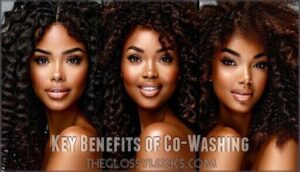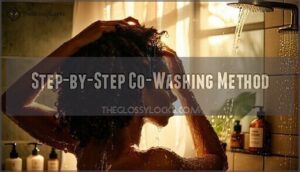This site is supported by our readers. We may earn a commission, at no cost to you, if you purchase through links.

It’s more than a trend—what is co washing if not a quiet rebellion against old routines? Born from the No Poo movement and championed by curly hair communities, this technique trades harsh detergents for gentle care.
Curiosity grows as more people discover their hair’s true texture hiding beneath the foam. There’s a reason co-washing has moved from niche to necessity for so many.
Table Of Contents
- Key Takeaways
- What is Co-Washing?
- Who Can Benefit From Co-Washing?
- Who Should Avoid Co-Washing?
- Key Benefits of Co-Washing
- How to Co-Wash Hair Properly
- Choosing The Right Conditioner for Co-Washing
- Potential Drawbacks and Precautions
- Frequently Asked Questions (FAQs)
- What are the benefits of co-washing?
- Are there any products specifically designed for co-washing?
- Is co-washing suitable for color-treated hair?
- Are there any potential drawbacks to co-washing?
- How often should I co-wash my hair?
- Can you use co-washing on kids hair?
- How does co-washing affect hair growth?
- Is co-washing suitable for protective styles?
- Can co-washing help with dandruff issues?
- Does water hardness impact co-washing results?
- Conclusion
Key Takeaways
- Co-washing means cleaning your hair with conditioner instead of shampoo, helping curls and dry hair stay hydrated and soft.
- This method works best for curly, coily, dry, or color-treated hair, but fine or oily hair types can experience buildup and limpness.
- Using the right conditioner—free from silicones and filled with moisturizing ingredients—prevents residue and keeps hair healthy.
- While co-washing reduces frizz and breakage, you still need occasional shampooing to clear out buildup and maintain scalp health.
What is Co-Washing?
Co-washing has become a popular alternative to traditional hair washing methods, especially for those looking to keep their hair hydrated. Before you jump in, it helps to understand what the term really means and where it started.
Here’s what you need to know before giving co-washing a try.
Definition and Origins
Think of co-washing as an evolution in historical hair cleansing. Instead of relying on harsh soaps—with roots going back thousands of years—the cowashing technique skips shampoo, using conditioner alone for gentle care.
Popularized through the No Poo Movement and Curly Hair circles, the term “co-wash” now anchors a growing cleansing conditioner market and sulfate-free shampoos. The co-wash market size reached $1.34 billion in 2024.
How Co-Washing Differs From Shampooing
Where cowashing uses conditioner’s gentle surfactant action to hydrate while cleansing, shampoo—especially those with sulfates—focuses on stripping oil and deeply removing residue.
This difference matters: cowashing aids oil retention, reduces cuticle damage, and leaves more residue, while traditional hair cleansing removes buildup but can disrupt your scalp microbiome and dry out strands, particularly on curly textures.
For curly hair, sulfate-free shampoos are often a great option.
Common Terms (No Poo, Conditioner-Only Washing)
These aren’t just internet buzzwords—they’re the language of a growing movement. “No poo” speaks to the origins of ditching shampoos altogether, while “conditioner-only washing” or “CoWashing” marks how the terminology evolved as brands introduced cleansing conditioners.
Each term captures a shift toward gentler, alternative nomenclature for a conditioning wash with real cultural impact—shampoo alternatives, minus the marketing spin.
Who Can Benefit From Co-Washing?
Co-washing isn’t just for one hair type—it offers something for a range of needs. Different hair textures and challenges can see unique benefits.
Here’s a closer look at who stands to gain the most.
Curly and Coily Hair Types
Ever wondered why so many people with curly and coily hair swear by co-washing? It’s all about better moisture retention and lasting curl definition.
With the right products, your curls become softer and less prone to frizz. Plus, scalp health usually improves.
Just remember, regular co-washing calls for occasional clarifying to avoid product buildup and keep things fresh.
Wavy and Dry Hair
When your hair feels more like straw than silk, finding gentle ways to bring back softness can make all the difference. Co-washing is a smart hydration method for dry or wavy hair—especially when seasonal changes make things worse. You’ll notice better curl definition, but watch for product buildup.
- Maintains scalp health
- Boosts hair hydration
- Enhances wavy texture
- Cuts down on dryness
Color-Treated and Damaged Hair
After all that time and effort keeping your color bright, the last thing you need is a harsh shampoo washing it down the drain.
Co-washing uses gentle ingredients to lock in color retention and hydration, while supporting protein balance and damage repair.
It’s a practical approach for color-treated hair care—offering gentle cleansing and conditioning to restore vibrancy without stripping away moisture.
Who Should Avoid Co-Washing?
While co-washing works wonders for many, it isn’t the perfect fit for everyone. Some hair types and scalp issues just do better with a different approach.
Here’s what to keep in mind before you skip the shampoo.
Fine or Oily Hair Types
Think your strands could double as an oil slick by lunchtime or fall flat no matter what you try? Co-washing mightn’t be your hair’s best friend. For fine or oily hair types, it can lead to:
- Extra oily scalp issues and limp roots
- Buildup concerns from insufficient cleansing
- Fine hair weighed down by moisture
- More frequent need for thorough hair cleansing
Scalp Conditions and Sensitivities
If your scalp gets irritated faster than a sunburn on the Fourth of July, it pays to tread carefully with co-washing. Sensitive scalps, product allergies, or pre-existing scalp conditions often react with burning, itching, or flakes.
Watch for irritation symptoms and buildup effects—balancing cleansing and scalp health is essential. Prioritize scalp health maintenance and consult a professional for scalp treatment and care.
When to Use Traditional Shampoo
Imagine this: your usual conditioner isn’t cutting through the grime, and your strands feel like they’re wearing a winter coat—that’s your cue for a good old-fashioned shampoo day.
Whether it’s infrequent shampoo frequency or heavy product use, scalp health and proper buildup removal matter. Rotate in a sulfate-free shampoo for gentle cleansing, especially if your hair type struggles with co-washing benefits alone.
Key Benefits of Co-Washing
There’s more to co-washing than just skipping shampoo. The right approach can offer several noticeable perks for your hair.
Here’s what you can look forward to as you make the switch.
Hydration and Moisture Retention
Surprised by how thirsty your hair can get? That’s where CoWash shines. Moisturizing conditioners deeply hydrate, safeguarding the cuticle and preserving up to 65% more of your natural lipids.
This boosts scalp moisture and curbs transepidermal water loss (TEWL), giving your strands elasticity and life. Cowashing benefits show up as lasting hydration and a touchably healthy feel.
Reduced Frizz and Breakage
When your hair gets the moisture it craves, you’ll notice frizz slip away and breakage start to take a back seat. CoWashing benefits kick in quickly—less frizz means curls keep their shape, tangles loosen, and your strands bounce with elasticity.
This regular dose of hair moisturizing is a true manageability boost and a big help for breakage prevention in curly hair care.
Healthier Scalp and Hair Texture
All that extra moisture keeps breakage in check and leaves your scalp feeling comfortable, with your curls looking smoother from root to tip.
Supporting your scalp microbiome and hydration balance, co-washing encourages healthier hair texture.
For many, the long-term effects include better scalp health, fewer buildup effects, and hair that behaves itself with less fuss.
How to Co-Wash Hair Properly
If you’re curious about how to co-wash your hair the right way, you’ll want to keep a few key steps in mind.
The process is simple, but paying attention to the details makes all the difference.
Here’s what you need to know before getting started.
Step-by-Step Co-Washing Method
Before you reach for that conditioner, let’s walk through co-washing step by step so you get the most out of every wash. Start with warm water for proper absorption, then apply a generous conditioner amount, focusing on Scalp Massage with your fingertips. Pause and let it absorb. CoWashing Techniques like these help curly hair stay hydrated and thriving.
- Wet hair thoroughly first.
- Massage conditioner into scalp and roots.
- Let conditioner sit before rinsing out.
Rinsing Techniques for Best Results
Once you’ve let the conditioner soak in, it’s time to rinse like you mean it—this step is where your hair gets that fresh, clean feeling without missing out on moisture. Use cool water and a gentle scalp massage to break up leftover product. Rinsing time should be double the lathering time for thorough product removal, especially for curly hair using sectioned rinsing.
| CoWashing Techniques | Rinsing Step | Feeling Afterwards |
|---|---|---|
| Scalp Massage | Cool Water | Refreshed Roots |
| Sectioned Rinsing | Extra Rinsing Time | Soft, Bouncy Curls |
| Conditioner Removal | Gentle Pressure | Lasting Moisture |
Frequency and Routine Tips
Some days, your hair feels like it craves a reset, while other times a quick co-wash is all it needs to bounce back.
Co-wash frequency depends on your unique curly hair care routine, seasonal adjustments, and scalp health.
Rotate products, add gentle scalp massage, and fit co-washing or night conditioning into your regular hair care routine for best results.
Choosing The Right Conditioner for Co-Washing
Not all conditioners are created equal for co-washing. The kind you choose can make or break your results, and your scalp will notice the difference.
Here’s what you’ll want to keep in mind before picking your next product.
Ingredients to Look for (Emollients, Humectants, Proteins)
If you want your co-wash to work wonders, it’s all about picking a conditioner packed with nourishing ingredients like emollients, humectants, and proteins.
- Emollient Benefits: Shea butter or argan oil lubricate and smooth hair.
- Humectant Types: Glycerin and honey pull in much-needed moisture for lasting hydration.
- Protein Sources: Wheat or soy protein strengthen strands, improving Hair Conditioning and resilience during CoWashing and Conditioning.
Avoiding Silicones and Buildup
Even though conditioners can feel like a treat, picking one with silicones might leave your hair feeling weighed down or looking dull over time. Watch out for buildup symptoms—like itchy scalp or limp roots.
Opt for silicone alternatives and stay mindful about ingredient awareness. If buildup does sneak in, regular scalp exfoliation and occasional clarifying shampoos help keep your routine balanced and sulfate-free.
Cleansing Conditioners Vs. Regular Conditioners
Think of cleansing conditioners as your hair’s multitasking roommate, blending the gentle touch of conditioner with just enough cleaning power to sweep away buildup—unlike regular conditioners, which focus solely on adding moisture.
Cleansing conditioners feature specific cleansing ingredients that help with scalp cleansing, support hair texture, and control buildup potential, making them an ideal pick for frequent co-washing.
Potential Drawbacks and Precautions
While co-washing offers plenty of benefits, it isn’t without a few things to watch out for.
Knowing the risks and how to spot early warning signs can help you keep your hair and scalp healthy. Here’s what to keep in mind as you weigh your options.
Risk of Product Buildup
Ever felt like your scalp’s wearing a winter hat in July? That heaviness comes from product buildup—especially Silicone Accumulation and heavy conditioners.
With co-washing, Cleansing Limitations mean these residues linger, which leads to Scalp Congestion and hinders Follicle Health. Regular Clarification Needs become essential.
Without it, your hair care game can stall, no matter how fancy your Hair Products or Product Recommendations.
Signs of Scalp Irritation
A scalp that suddenly itches, flakes, or feels sore is your head’s way of waving a red flag that something’s not quite right. Watch for these signs:
- Persistent Itchy Scalp
- Redness Symptoms after cleansing
- Flaky Skin along the hairline
- Greasy, oily buildup that returns quickly
- Odd rashes—possible contact dermatitis
Your scalp’s health matters; don’t ignore these signals.
Balancing Co-Washing With Occasional Shampooing
It’s easy to wonder how often you should reach for shampoo after spotting some irritation or buildup. Finding that sweet spot between co-washing and traditional cleansing can make all the difference for your scalp and hair. Alternate cowashing with a sulfate-free shampoo as needed—your frequency depends on hair type, buildup prevention, and scalp health.
| Hair Type | Shampoo Frequency |
|---|---|
| Fine/Oily | Weekly cleansing recommended |
| Curly/Coily | Biweekly or as buildup starts |
Frequently Asked Questions (FAQs)
What are the benefits of co-washing?
Hydration benefits top the list for curly hair, with co-washing locking in moisture.
You’ll notice less frizz, fewer breakage issues, better scalp health, and smoother texture—making cowashing a go-to hair care move for many.
Are there any products specifically designed for co-washing?
Picture your hair as a garden—Cleansing Conditioners act like gentle rain, designed just for co-washing.
You’ll find options packed with Cowash Ingredients, earning high marks in Product Reviews, and boosting Scalp Health for Curly hair.
Is co-washing suitable for color-treated hair?
Color-treated hair often thrives with co-washing, thanks to its hydration balance and sulfate-free benefits.
Just be mindful of product compatibility—using the wrong formula may contribute to pigment stripping or buildup, affecting ColorTreated Hair Care.
Are there any potential drawbacks to co-washing?
Lila noticed her scalp itching after weeks of co-washing, despite initial curly hair manageability gains.
Scalp buildup, oily scalp, and contact dermatitis can happen, dulling product effectiveness.
Different hair types need specific scalp health tips for ongoing hair breakage prevention.
How often should I co-wash my hair?
Co-wash frequency depends on your hair type and scalp health. Curly hair benefits from co-washing every few days, while others might need less.
Adjust routines seasonally, watching for product buildup or dryness to keep hair hydrated.
Can you use co-washing on kids hair?
Co-washing can work for children, especially with curly hair, if you prioritize product safety and age appropriateness.
Consider your child’s hair texture, natural hair care needs, and kids scalp health before making it part of their routine.
How does co-washing affect hair growth?
Like tending a garden, co-washing keeps hydration levels high and can minimize breakage, supporting a healthy growth cycle.
However, scalp buildup from inadequate cleansing may affect hair growth strategies, especially in coily hair or curly hair management routines.
Is co-washing suitable for protective styles?
Co-washing can help keep protective styles hydrated and soft, but it’s best when scalp access is easy.
Watch for protective style buildup, choose product compatibility for your curly hair management, and balance moisture for style longevity and healthy hair care.
Can co-washing help with dandruff issues?
Balancing moisture, soothing the scalp, encouraging softness—co-washing feels gentle, but when dandruff causes scalp buildup, conditioner alone may not cut it.
For true scalp health and care, alternate with targeted shampooing for effective hair cleansing and shampooing.
Does water hardness impact co-washing results?
Hard water minerals cling to hair, making conditioner less effective during co-washing and often disrupting scalp pH balance.
Mineral buildup effects can block hydration, so chelation or soft water aids moisture retention and maximizes cowashing benefits.
Conclusion
Imagine running your fingers through hair that feels softer with every wash—yet you’re still wondering, could skipping shampoo be the very thing your hair is craving? The answer lies in what’s co-washing: a practice that dares you to break old cycles.
Your hair’s true nature could be more vibrant than you can guess. One shift in your routine might reveal a healthier texture, and that simple choice? It’s yours, and it changes everything.











